January 23, 2018
Walk into any gym in the country and the chances are good that you will see treadmills, elliptical machines, stationary bikes, strength machines, and free-weights. You may also notice that kettlebells have recently enjoyed a resurgence as a must-have piece of fitness equipment for the modern athlete and fitness trainer, but the iconic instrument has been used for fitness training for hundreds of years.
The weights feature a handle with a round base and have been recorded in cultures ranging from the Shaolin monks of ancient China to the wise philosophers of ancient Greece. Known as “ring-handled weights” and “stone padlocks”, these tools from ancient times were used to garner strength and develop the human physique. Even the tribes of Scotland had a version of a weight with a handle that was used in Highland Games.
Although several different cultures around the world developed some variation of the kettlebell weight in their time, it wasn’t until the turn of the 21st century that the fitness training device became a staple in modern workout routines. The new wave of kettlebell enthusiasm erupted in 2001, when Pavel Tsatsouline, a former Soviet Special Forces Instructor, relocated from Belarus to the United States and sparked a revolution in the fitness world. His methods are now incorporated in training regimens for the U.S. Navy SEALs, the U.S. Marines, and the U.S. Army Special Forces, among others. Despite the nearly unanimous conclusion that Tsatsouline popularized kettlebell weights in the West and started the current kettlebell craze, fitness experts are uncertain as to where the kettlebell truly originated in history.
In today’s article, you’re going to discover more of the fascinating history of the kettlebell, and how you can personally use it for strength, power, rehab, massive calorie burning, functional movement and much more. This is currently a topic near and dear to my heart because I am headed down to San Francisco in a couple weeks to complete my very first “RKC” (Russian Kettlebell Certification), with my friend and former podcast guest Chris Holder and the folks at Dragon Door publications. Stay tuned to my Instagram and Facebook page for plenty of juicy images and helpful kettlebell tips from that experience.
OK, let’s jump in.
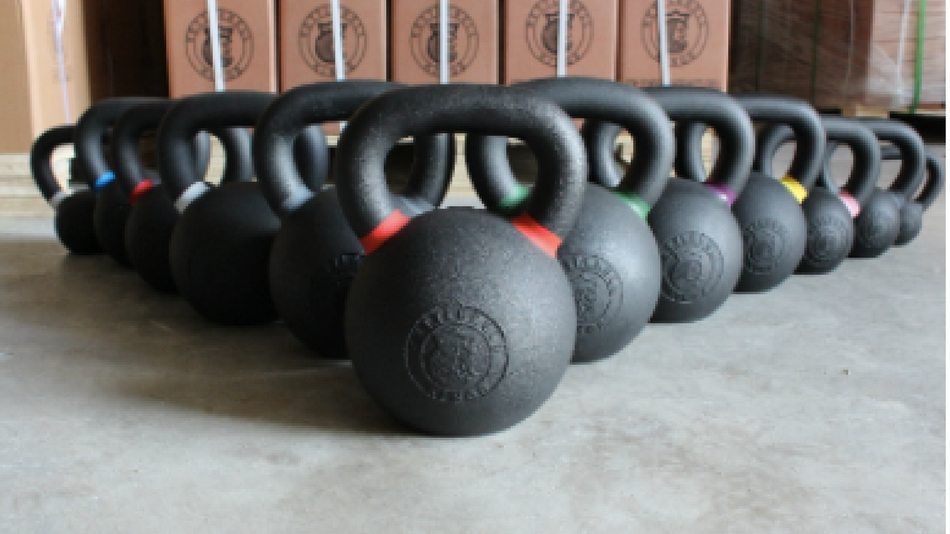
Russian Heritage
The Russian term for kettlebell weights, giro or girya, first appear in Russian dictionaries dating as far back as 1704, nearly seven decades before the United States declared independence from Great Britain. Historians speculate that the word originated from the Persian word for difficult, “gerani,” and the Slavic word for a bubble, “gur.”
Russian farmers first used the handled objects as counterweights to measure dry goods on scales in the marketplace. The weights were measured in “poods” (about 36.11 pounds), and kettlebells are still measured by the pood in Russia and former Soviet states.
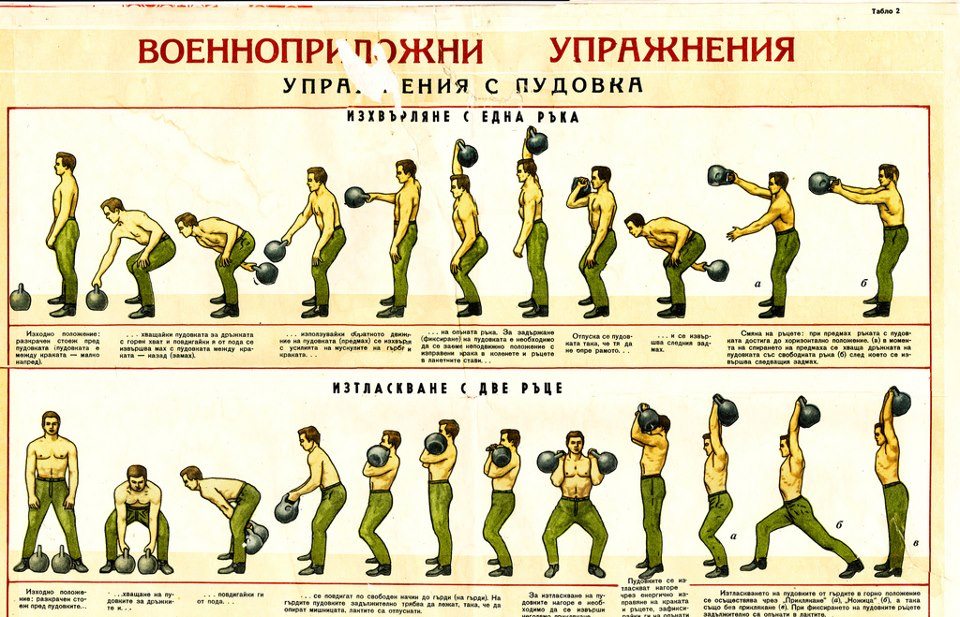
In their free-time, people began throwing the weights for entertainment, and farming festivals embraced the activity as a new type of strongman competition. Athletic farmers would compete by hurling the weights as far as possible to demonstrate their strength and endurance. Other forms of kettlebell competitions began to develop, and eventually, kettlebells became very popular across Russia. To prepare for the games, the kettlebell weights were used for bodybuilding and strength conditioning and were considered a household item across the country.
By 1900, Dr. Vladislav Krayevsky, a Russian physician, was working on what he described as “heavy athletics.” Considered a forefather of the modern fitness gym, he founded the St. Petersburg Amateur Weightlifting Society and created what is now considered the birth of Russian weightlifting. He wrote a book titled “The Development of Physical Strength with Kettlebells and without Kettlebells,” detailing ways to maximize the human body as a tool for strength. As one of the greatest influences of the time, Dr. Krayevsky is credited by the legendary strongman George Hackenschmidt, known as “The Russian Lion,” who claimed the doctor taught him everything he knew about fitness training. Another prolific disciple of Dr. Krayevsky was Eugene Sandow, credited as “The Founder and Father of Modern Day Bodybuilding.”
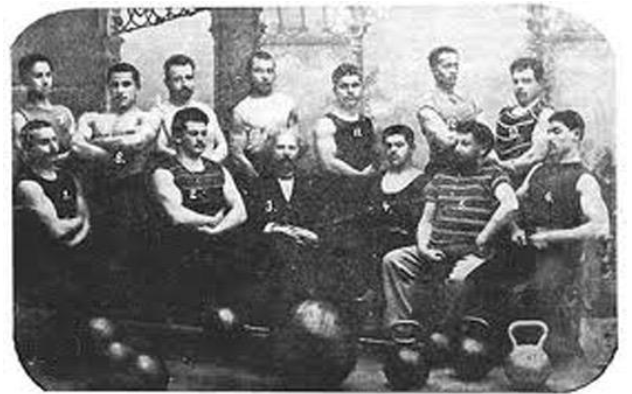
Dr. Krayevsky’s influence was not isolated to fitness enthusiasts; he was also the personal physician of Czar Nicholas II, the last emperor of Russia. The Czar was so impressed with the effectiveness of the kettlebell weights in his own workouts that he ordered his military to begin training with them in preparation for future battles. As kettlebell strength-training became more popular, the activity was named the national sport of the Soviet Union in 1948, but others across Europe had also begun using kettlebells in their weight training.
Incidentally, I’ve actually written about Eugene Sandow and some of these other crazy cats involved in the history of exercise in this Quick & Dirty Tips article on “Natural Movement”, which is actually a pretty fun read in and of itself if you’re interested in the history of physical culture, and items that go beyond the kettlebell, such as the sandbag, the keg, playground equipment and more.
German Influence
Germany is known for their rich history of physical fitness programs. Friedrich Ludwig Jahn was a physical educator in Germany in the late 18th century and founded the Turners System of Gymnastics. Turners System became a foundation for the physical education system used in the West, and historians have unearthed diagrams and pictures of his followers using kettlebell weights in their workouts.
The documents suggest that Germans were among the first to utilize kettlebells in their workout programs and that they recognized the effectiveness of constantly varied functional-movements, ideal for kettlebell use, to develop their strength and physiques.
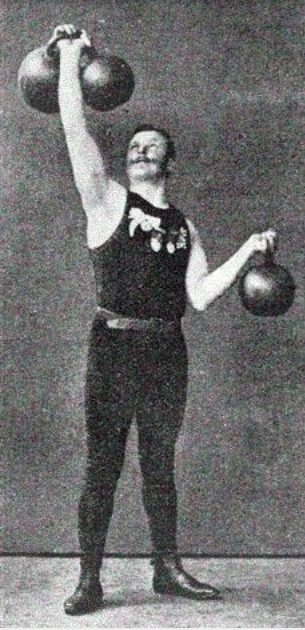
During the late 1800s, globalization started to swell with international travel becoming a more common human experience and foreign influences began interacting with other cultures. Experts believe that Dr. Krayevsky may have first observed kettlebells being used in 1898, during a strongman gathering in Vienna, Austria. Theodore Siebert, a groundbreaking German trainer, was also at the conference and used heavy kettlebell swings in his workouts. The doctor likely incorporated the new weight into his workouts after witnessing an impressive display of human strength at the international gathering. After all, it was only two years later that he wrote his famous book about kettlebell weight training.
Greek Involvement?
Some historians argue that ancient Greece played a role in developing the current kettlebell weight. The ancient culture glorified the human physique and is credited with developing a predecessor to handheld weights, called “halteres”. Athletes would use the weights to train for battle, sports, and bodybuilding.
Although the weights of ancient Greece had handles, they did not have a uniform design and experts debate whether or not the weighted apparatus had any influence on developing the modern kettlebell.
American Acceptance
Strongmen from all over the world found careers performing their lifts in front of an audience, and the United States had a strong enough economy to put these types of acts in high demand. Attractions ranging from wandering circus acts to local fairs and festivals hosted these performances, and kettlebell weights were at the forefront of these impressive displays of human strength. Traveling from foreign countries, these strongmen showcased kettlebell workouts for the first time and proved how effective the weights could be used to develop power.
In 1912, a German strongman who performed under the name Attila was featured in a New York Herald piece after showing off his ridiculous strength. The sixty-seven-year-old lifted two seventy-five pound kettlebells above his head and held another eighty-five-pound weight with his teeth. Attractions like these were popular near the turn of the century, but kettlebells disappeared in the West by the end of the second World War.
Mysterious Disappearance
Research into the history of kettlebell use has revealed a fascinating trend in the 40's and 50's when kettlebells mysteriously disappeared from American fitness culture without any apparent explanation. World War II was winding down, and the United States was beginning to engage the Soviet Union for several decades in what became the Cold War. Kettlebell swings had been a standard exercise among farmers in Russia for hundreds of years and had just recently become the Soviet Union’s national sport.
In 1948, the Soviet Union refused to attend the Summer Olympics in London, and instead, hosted a competition for Soviet strongmen in Moscow. The kettlebell was featured in two of the events: the long jerk and the biathlon. Contestants competed in the long jerk by performing a clean and a jerk using two kettlebells, and the biathlon consisted of a set of jerks with two kettlebells, followed by a set of snatches.
Recognized as a proud symbol for the Soviet Union, some historians wonder if Cold War sentiments pushed the kettlebell out of mainstream American culture. The Soviet Union continued to struggle after the World War, and the United States experienced exceptional economic growth and advancements in infrastructure.
As Hollywood boomed in the 40’s and 50’s, America’s appetite for fashion grew and physical fitness gained a new level of attention from the population. The fitness industry met the demand with new workouts focused on isolation exercises instead of traditional, full-body exercise movements. American patriotism was at an all-time high, and the public was eager to show their support for the U.S. in any way possible. There is a possibility that Americans discarded the handled-weights to separate themselves from Russia and the rise of Communism.
The Cold War was not the only conflict on America’s plate. Two of the nation’s leading fitness tycoons, Joe Weider and Bob Hoffman, were coming to prominence at the time, and American gyms were caught in the middle of a battle for the soul of strength training. Joe Weider and his brother, Ben, developed a system of workouts focused on physique and body image, promoting the old notion that if you train for shape, then strength will come. However, Bob Hoffman of York Barbell encouraged training the body for performance. As a weightlifter, Hoffman believed that muscles should be developed for a purpose, not just for glamorous looks. In the end, he eventually began catering to bodybuilders because of the tremendous demand for bodybuilding merchandise from the public.
The two systems for building muscle mass were wildly popular across the country, and American gyms gained a lot of members because of these programs. Despite their focus on muscle development, neither one used kettlebells in any of their workouts. Of course, it is possible that the kettlebell trend faded at the time because the public wanted to try something new.
The Resurgence of Kettlebells in Western Culture
Primarily credited with bringing the kettlebell back into Western culture in the 21st century, Pavel Tsatsouline (who I first mentioned here) came to the United States shortly after the Berlin wall collapsed. He first became a kettlebell instructor in 1998 and holds a degree in Sports Science from the Physical Culture Institute in Minsk. The Russians were still using kettlebells as equipment for their national sport and competitions, but personal fitness is a unique type of physical challenge with a different mindset that Pavel was able to master.
Pavel made the workouts fun with his stereotypical use of “comrade,” intentionally thick accent, and a dark, dungeon-y backdrop. His instructional videos and training courses comically exploited Soviet stereotypes that proved to be very successful at keeping viewers engaged by adding an element of entertainment to the challenging workouts. It didn’t take much for the public to discover the real benefits of kettlebell training, and the craze has yet to fade.
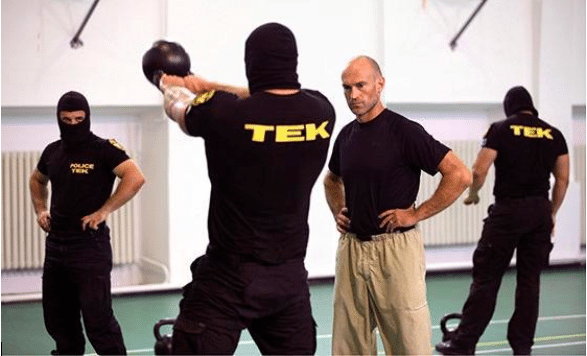
Other kettlebell experts fled to the U.S. after the Soviet Union collapsed, and it is very likely that they influenced American fitness culture with their foreign exercise routines using kettlebells. However, Pavel’s success came from his ability to advertise and market the unique style of workouts, and experts agree that he deserves the credit for making kettlebells as popular as they are today.
Kettlebells have been gaining attention now that the fitness industry is shifting away from cosmetic workouts to focus on movement-based exercise, also known as functional fitness training, and kettlebells are the perfect tool to target multiple muscle groups in one exercise. These full-body exercise routines burn more energy than traditional weight lifting, and kettlebells don’t require a lot of space to store. A study in 2010 from the American Council of Exercise found that kettlebell workouts burn about 20 calories per minute, which adds up to 1,200 calories per hour and burn more calories than dumbbell training. The exercises also target multiple muscle groups so that full-body workouts can be achieved more efficiently.
How Athletes Use Kettlebells Now
Traditional weight use is focused on individual sets with low repetitions and heavy loads, but kettlebell workouts offer a different approach. Specific exercises for kettlebell weights are designed to burn fat, build endurance, and develop strength by using the weights with high repetitions at a fast pace.
Working the muscles in this manner physically breaks down the microfibers that make up the muscle tissue and creates a chemical response from the body that stimulates muscle growth and burns fat. While kettlebells and dumbbells can be used interchangeably for some exercises, such as bicep curls or lateral raises, the real success of kettlebell weight training comes from using the weights non-traditionally.
If done correctly, kettlebell training is an efficient way to build athletic skills and will increase an athlete’s strength, mobility, balance, coordination, and stamina.
Warm-up
Warming up the body is a crucial component to the beginning of any workout. Professional athletes and exercise enthusiasts recognize that a thorough warm-up can prevent unintentional injuries and prepares the body to perform at a higher level of intensity. Kettlebells are an ideal instrument for warm-ups because of the dynamic motions that activate separate muscle groups in the same exercise. By engaging multiple muscle groups in a consistent motion, blood-flow is increased, and the body is more prepared to react to physical strain.
Cardio
The versatile nature of kettlebell workouts allows athletes to target different areas of their performance with one type of weight. Cardio workouts that focus on kettlebells are an excellent way to burn fat by adding weights to ballistic exercises. These types of exercises force the body to transition the added weight between different muscle groups for a certain amount of time, increasing the heart rate, and creating a “fun” way to burn fat. A common type of cardio routine combines aerobic activities, such as jogging or jump roping, with sets of ballistic kettlebell exercises, like swings and snatches. Athletes that work through ten rounds of heavy kettlebell exercises will notice a huge boost to their strength conditioning.
Recovery
Kettlebells are also a great tool for healing and recovery. Programs that encourage athletes to work through injuries using light workouts every week can speed up their recovery time by boosting blood flow to affected areas of the body. Blood flow is critical for recovery because the blood delivers vital nutrients throughout the body that helps the recovery process. Popular kettlebell exercises involve hip extensions, a fundamental aspect of athletic motions, such as running, jumping, turning, squatting, and bending. Using kettlebells to train the muscles will increase the flexibility of athletes in ways that affect their performance through underlying motions that are fundamental to sports. One of the most essential qualities of the kettlebell is the offset center of gravity that maximizes joint strength and flexibility, especially in the major joints.
Strength
The unique shape and weight distribution of kettlebell weights make them ideal for professional athletes, already familiar with traditional dumbbells and free-weights, to challenge their bodies to adapt to a new form of strain. Dumbbells have a linear distribution of weight that is in-line with the handle, but kettlebells are different. The weight of the kettlebell is in front of the handle, and this subtle, but significant distinction is why professional athletes find even the most basic kettlebell movement can increase the demand of flexibility from an exercise. Pushing through kettlebell workouts is a popular way for professional athletes to change their exercise programs dramatically.
It almost seems too good to be true, but kettlebell exercises allow athletes to combine the benefits of anaerobic, aerobic, and strength conditioning into one workout. Because of the motions involved, workouts that utilize kettlebells require deep focus and the full attention of the body and mind. Kettlebell exercises also include an element of flexibility and help athletes prevent injuries by building greater ranges of motion.
Kettlebells Are For Everyone
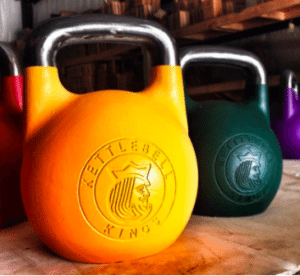
Kettlebells are used by collegiate athletes, professional competitors, military specialists, and fitness enthusiasts alike, but fitness experts recognize their exceptional versatility. The benefits of using kettlebells to build strength and condition the body’s muscles apply to all ages, regardless of your level of fitness, and they don’t require a lot of storage space to keep them around the house.
The advantages of using kettlebells exceed other forms of free-weight training because of the way the exercises incorporate different muscle groups, providing a full-body workout that is more natural for the body.
As the weight shifts from muscle group to muscle group, the brain creates connections that unite the body as one synergistic unit. The benefits of having a natural and seamless transition from one group of muscles to the next is a huge reason that professional athletes now use the kettlebell-weight in their daily workouts. With more communication amongst the body’s neural networks, injuries are less likely, and the body reacts more seamlessly than traditional training can provide.
Forcing the body to transition between muscle groups is a great way to train for real-world applications of muscle groups. Individuals that use kettlebells in their workouts develop an increased range of motion and enhance mobility, providing essential health benefits to people as they age. Experts recommend this type of exercise for people concerned about mobility, power, agility, and endurance.
The health-conscious individual has a lot to gain from using kettlebell-specific workouts. Most people want to stay healthy and in shape, but can’t afford to spend hours in the gym finely tuning every fiber of muscle in their body. The full-body nature of kettlebell workouts provides significant results in a shorter amount of time simply because multiple muscle groups are involved in each exercise.
How To Select a Kettlebell
When selecting a kettlebell to start a new routine, there are three things you want to consider:
- What type of workout do you intend to do? Are you going for explosive, quick movements like kettlebell swings, snatches, cleans, and tosses, or are you going for slower, “grind-it-out” movements like presses, windmills, and Turkish get-ups? Based on the type of workout you intend to do, you may want to go with a lighter weight (explosive lifts) or a heavier weight (grinds).
- What type of handle are you most comfortable with? Kettlebell handles come in thinner and thicker diameters, so look for a provider that has both 33mm and 35mm handles, to give yourself more buying options.
- What is your current fitness level? Experienced lifters may be able to start with a heavier weight than someone who is just getting their fitness regimen off the ground.
The recommended starting weight for men is either a 35lb (16kg) or 44lb (20kg) kettlebell. Women who are just starting out may wish to begin with an 18lb (8kg) or 26lb (12kg) weight.
Kettlebell Exercises
Three standard kettlebell exercises to get you going with your new workout include the swing, the clean-and-press, and the squat. Here’s how to perform each exercise:
The Swing
The swing is one of the bedrock movements in any kettlebell routine and is an exercise that targets the shoulders, legs, back, glutes and hips. In order to perform the movement:
- Stand up straight with your feet a little wider than hip-distance apart
- Grab the handle with both hands, palms facing down
- Slightly bend the knees and drive the hips back (but not too low, you should not be in squat formation!)
- In one fluid motion, drive the hips forward and swing the kettlebell, remembering to keep your core and glutes engaged. This is not an arm movement, but is an entire body movement, driven by your hips!
When it comes to swing form (or any other kettlebell form), stick to listening to the experts. Here's my friend Mike Salemi along with the guys from Mindpump dishing out perfect swing advice:
The Clean and Press
This full-body motion works the legs, core, arms and shoulders. In order to perform the clean-and-press:
- With the kettlebell on the floor, hold the kettlebell by its handle with an overhead grip. Your knees should be bent and your feet should be slightly wider than hip-distance apart.
- Do the kettlebell clean, lifting the kettlebell off the ground and pulling it towards the shoulder. At the end of the clean, the kettlebell should be locked in position at the shoulder, ready for the press.
- Keeping your torso upright, bend your knees
- Press the kettlebell over your head
- Return the kettlebell to the “rack” position by your shoulder, and lower to the floor
Once again, enter Mike (world Kettlebell Clean and Jerk champion, by the way):
The Goblet Squat
This version of the classic squat incorporates the kettlebell as additional weight, and targets the legs, back, and glutes. To perform the goblet squat:
- Keeping your elbows close to the body, stand up straight while holding the kettlebell in front of your chest with both hands
- Squat while pushing your heels to the ground and pushing your hips back. Your thighs should either be parallel to the ground or a bit lower
- Return to a standing position and repeat!
Enter you know who to show you a hard style kettlebell goblet squat, along with some other great moves:
Kettlebell training increases strength without necessarily building bulk, which is ideal for people who want to stay in shape and are already happy with their body image. Others that want to build muscle mass use the kettlebell as a warmup tool and enjoy the noticeable increase in everyday functioning. Heavy kettlebells are used by individuals that want to develop mass quickly, and the workouts can be designed for whatever personal fitness goals you want to achieve. Like all forms of exercise, the most important thing to remember is maintaining proper form. From enhancing your shape to building mass, the kettlebell has helped millions of people achieve their personal fitness goals for centuries.
Summary
Want more kettlebell fodder? Then I’d recommend the following podcast episodes:
-A Legendary Strength Coach’s Secrets to Build Mass Fast Without Destroying Your Body.
One Potent Tool And Three Simple Exercises To Gain Massive Endurance In Minimum Time.
And if you’d like to get a kettlebell for yourself, then I’d highly recommend the folks at Kettlebell Kings, who were first introduced to me by former podcast guest Mike Salemi.
Why?
Kettlebell Kings is the first company ever to offer totally free shipping and lifetime warranty on all kettlebells.
Yep, that’s right: you can get a heavy, hefty object like a kettlebell – as many as you’d like – shipped to your house without paying a dime for shipping. They also create free, weekly workouts you can sign up to receive straight to your email inbox here. In addition to these workouts, they also have a ton of free educational content on their website.
Finally, for those of you lucky enough to make it to the end of this article, Kettlebell Kings is offering a big, fat discount on any of their kettlebells, which are already a slammin’ deal. Just click here and use discount code Greenfield to get a 15% discount on any kettlebell in their store.
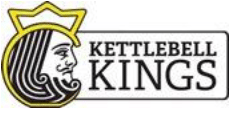
If you have questions, thoughts or feedback about kettlebells and kettlebell training, leave your thoughts below and I’ll be happy to reply!

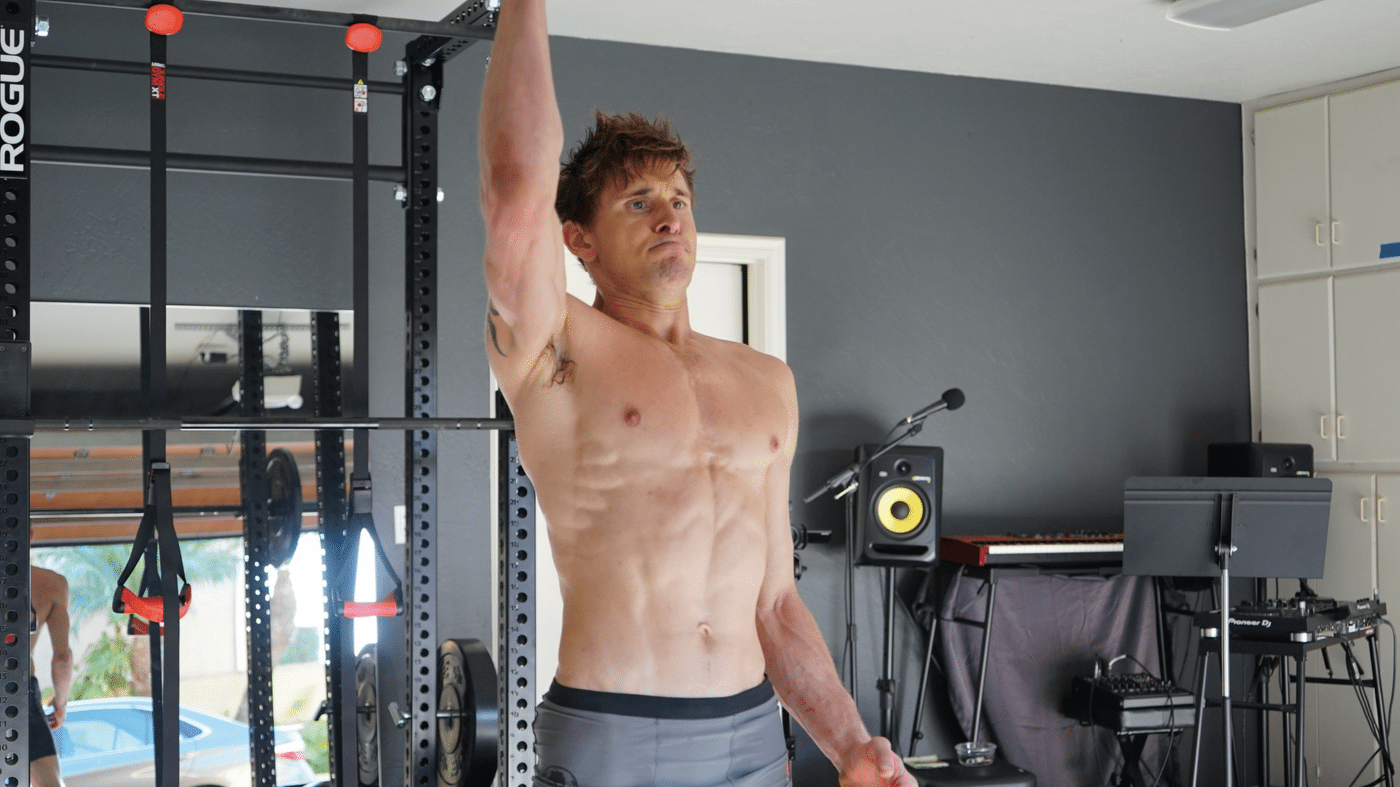
I saw those things in the gym but never used them. After reading this article, I definitely will be using them. Very well-written and informative post.
Thanks for sharing a useful and detailed article. This article really inspired me a lot about Kettlebell exercises.
Many times I’ve seen certified instructors in gyms teaching a what I call a “locked” style, when techniques performed very rigidly, i.e. eliminating most of natural body movements, rotations, slight turns, etc., anything that one would have used to naturally perform a snatch, clean and press and so on. As if they were a robot, haha. For example, the last part of a clean and press, these robots engage only a lifting motion, without engaging the rest of the body, which I found rather odd! I was even told this is the way to do it, haha! A Russian special police, or Pavel said that’s the right way. But that goes again the nature! All my life I did it with a slight hip rotation a tiny help from the legs. I wonder if you looked at different schools or approaches and how do you prefer to do it?
Thank you Ben.
Quick question, how do you take care of your bone, ligament and tendon health while lifting heavy? I’ve only recently started working out, and my trainer advices me to go heavy on most of the exercises. As I recall, I’ve seen bodybuilders lifting heavy during their initial days but later go through several injuries. How do I ensure I’m lifting heavy, while also taking care of my bone health?
Thanks in advance!
It’s funny how cyclical trends are. You have a basic kettlebell that’s been around forever and all of a sudden it’s popular again as though it’s just been discovered. Great, super detailed article amigo. Thanks for all the insights. Thoughts on adjustable kettlebells?
Thanks for sharing. I also get-up and snatch are also essential KB excercises
Great article!
I always tend to shift to Kettlebell or home workout when I’m done or bored with the usual gym workouts. I’ve got a set of Kettlebell at home, and usually use them half of the time. Works great and more fun!
Kettlebell workouts are such a great alternative to normal resistance training. I usually do half of my workouts using kettlebells and calisthenics to change things up a bit when resistance training becomes mundane.
Very helpful information. Thank you And also a great site about sports equipment https://thefitnessgo.com
Thank! Great article!
Interesting and informative article. I only recently found out about the German origins of kettlebell training. I noticed a small inaccuracy (or was it intended?) The military poster you use as an illustration is apparently not Russian, as it is written in Bulgarian. Keep up the good work!
Saw those things in the gym but never used them. After reading this article, I definitely will be using them. Nicely written. Thanks
I haven’t spent much time on kettle bells but I do see them being used quite a lot these days in the gym. Must look into trying them some more.
Thank you for the great post! Great video. I enjoyed watching them.
They have kettlebells at the school I work at. Got to do some squats with them and they were more comfortable than barbell squats for sure.
Solid post, come over and guest post any time ;)
Thanks for the detailed article….I’m an 81 year old kettlebell/bodyweight instructor in Goodyear, AZ….large classes full of enthusiastic seniors….love them all…Regards, Wally Chute, Certified Fitness Instructor
PS..Been teaching various conditioning classes for 48 years….enjoy KB classes the best!
Terrific summary. Thank you. I’ve used the kettlebells for several years and absolutely love it over more traditional weight training methods.
So damn good and detailed article. Thank you Ben for publishing. Article bookmarked.
Hey Ben. This was a really well written and detailed article. I recently started adding kettlebell swing after my deadlifts as a conditioning exercise for fast-twitch muscles. After reading this article i’m going to start incorporating it into my recovery and mobility exercises as well.
Thanks for publishing! Let us know how we can help!
Hi Ben, thank you for this article! I prefer kettlebells to dumbbells and machInes not because I grew up in the former USSR, and they were everywhere. I actually used to prefer machines, and was heavily influenced by the bodybuilding boom of the late 80s, when the wall had fallen and American culture had poured in. Just recently I have rediscovered them. They are a great time saving tool and give me run for the money! I have a question:
– Many times I’ve seen certified instructors in gyms teaching a what I call a “locked” style, when techniques performed very rigidly, i.e. eliminating most of natural body movements, rotations, slight turns, etc., anything that one would have used to naturally perform a snatch, clean and press and so on. As if they were a robot, haha. For example, the last part of a clean and press, these robots engage only a lifting motion, without engaging the rest of the body, which I found rather odd! I was even told this is the way to do it, haha! A Russian special police, or Pavel said that’s the right way. But that goes again the nature! All my life I did it with a slight hip rotation a tiny help from the legs. I wonder if you looked at different schools or approaches and how do you prefer to do it?
Thank you!
Do them like Mike does them in the video above!
Awesome to hear
Hey Ben: About time you saw the light!! :-) I went through Pavel’s RKC in 2006 at age 65. Since then I’ve been through the IKFF and IKSFA certifications. I currently teach Kettlebell Sport at Fitness XT In Big Rapids, MI. At 76, I’m the oldest competitor in Kettlebell Sport in N. America and #2 in World at the IUKL Championships in 2015 Dublin, Ireland.
Kettlebells awesome tool.
I think the get-up and snatch are also essential KB excercises.
If we want to boil it down to the 2 most primary and essential KB excercises its:
The get-up
The swing
Squats, snatches, cleans and presses can be done with a barbell but swings and get-ups are KB specific.